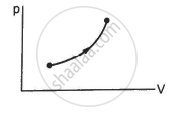Advertisements
Advertisements
प्रश्न
An air bubble of volume 1.0 cm3 rises from the bottom of a lake 40 m deep at a temperature of 12 °C. To what volume does it grow when it reaches the surface, which is at a temperature of 35 °C?
उत्तर १
Volume of the air bubble, V1 = 1.0 cm3 = 1.0 × 10–6 m3
Bubble rises to height, d = 40 m
Temperature at a depth of 40 m, T1 = 12°C = 285 K
Temperature at the surface of the lake, T2 = 35°C = 308 K
The pressure on the surface of the lake:
P2 = 1 atm = 1 ×1.013 × 105 Pa
The pressure at the depth of 40 m:
P1 = 1 atm + dρg
Where,
ρ is the density of water = 103 kg/m3
g is the acceleration due to gravity = 9.8 m/s2
∴P1 = 1.013 × 105 + 40 × 103 × 9.8 = 493300 Pa
We have : `(P_1V_1)/T_1 = (P_2V_2)/T_2`
Where, V2 is the volume of the air bubble when it reaches the surface
`V_2 = (P_1V_1T_2)/(T_1P_2)`
`= ((493300)(1.0 xx 10^(-6))308)/(285 xx 1.013 xx 10^5)`
= 5.263 × 10–6 m3 or 5.263 cm3
Therefore, when the air bubble reaches the surface, its volume becomes 5.263 cm3
उत्तर २
Volume of the bubble inside, `V_1 = 1.0 cm^3 = 1xx10^(-6) m^3`
Pressure on the bubble, `P_1` = Pressure of water + Atmospheric pressure
= `pgh + 1.01 xx 10^5 = 1000 xx 9.8 xx 40 + 1.01 xx 10^5`
`=3.92 xx 10^5 + 1.01 xx 10^5 = 4.93 xx 10^5` Pa
Temperature, `T_1 = 12 ^@C = 273 + 12 = 285 K`
Also, pressure outside the lake, `P_2 = 1.01 xx 10^5 n m^(-2)`
Temperature, `T_2 = 35 ^@C = 273 + 35 = 308` K, Volume `V_2` = ?
Now `(P_1V_1)/T_1 = (P_2V_2)/T_2`
`:. V_2 = (P_1V_1)/T_1. T_2/P_2 = (4.93xx10^5xx1xx10^(-6)xx 308)/(285 xx 1.01 xx 10^5) = 5.3 xx 10^(-6) m^(-3)`
APPEARS IN
संबंधित प्रश्न
Consider a mixture of oxygen and hydrogen kept at room temperature. As compared to a hydrogen molecule an oxygen molecule hits the wall
Calculate the mass of 1 cm3 of oxygen kept at STP.
The density of an ideal gas is 1.25 × 10−3 g cm−3 at STP. Calculate the molecular weight of the gas.
Use R=8.31J K-1 mol-1
Estimate the number of collisions per second suffered by a molecule in a sample of hydrogen at STP. The mean free path (average distance covered by a molecule between successive collisions) = 1.38 × 10−5 cm.
Use R = 8.31 JK−1 mol−1
A vertical cylinder of height 100 cm contains air at a constant temperature. The top is closed by a frictionless light piston. The atmospheric pressure is equal to 75 cm of mercury. Mercury is slowly poured over the piston. Find the maximum height of the mercury column that can be put on the piston.
The ratio Cp / Cv for a gas is 1.29. What is the degree of freedom of the molecules of this gas?
Work done by a sample of an ideal gas in a process A is double the work done in another process B. The temperature rises through the same amount in the two processes. If CAand CB be the molar heat capacities for the two processes,
For a solid with a small expansion coefficient,
Let Cv and Cp denote the molar heat capacities of an ideal gas at constant volume and constant pressure respectively. Which of the following is a universal constant?
The figure shows a process on a gas in which pressure and volume both change. The molar heat capacity for this process is C.

